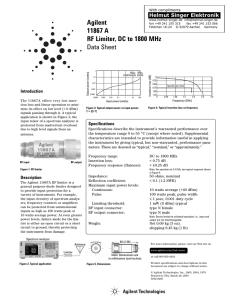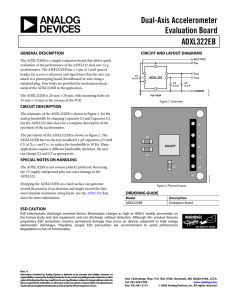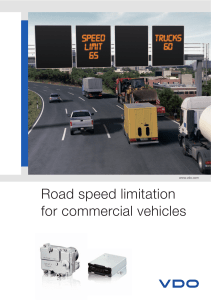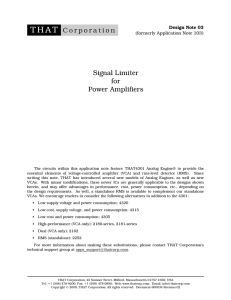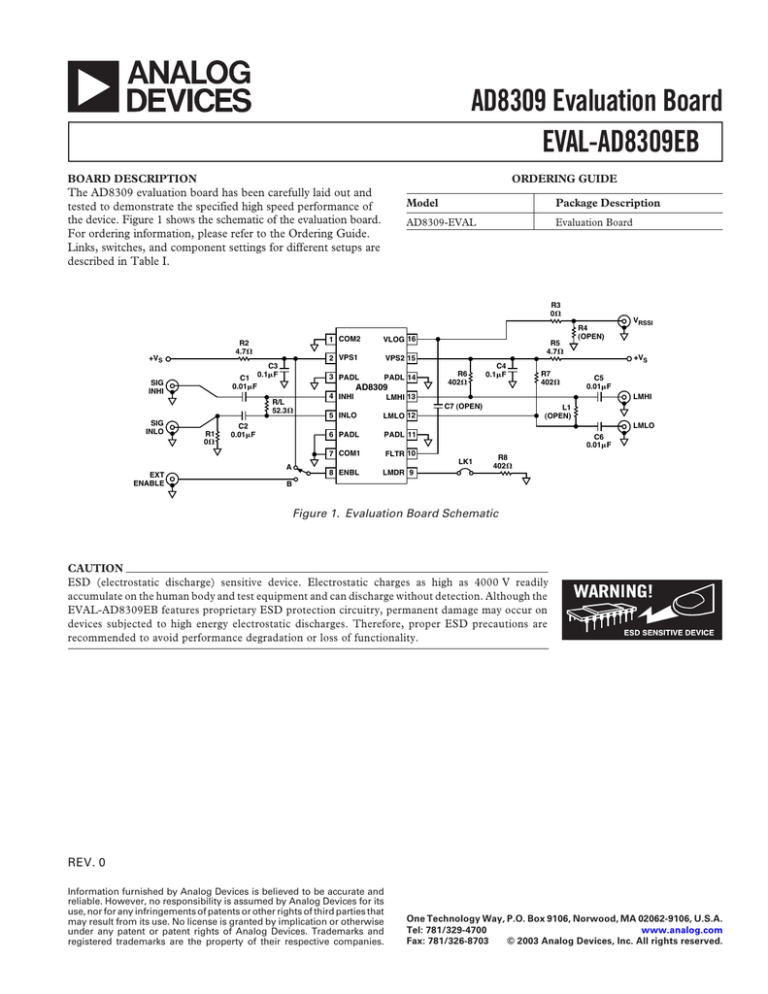
AD8309 Evaluation Board
EVAL-AD8309EB
ORDERING GUIDE
BOARD DESCRIPTION
The AD8309 evaluation board has been carefully laid out and
tested to demonstrate the specified high speed performance of
the device. Figure 1 shows the schematic of the evaluation board.
For ordering information, please refer to the Ordering Guide.
Links, switches, and component settings for different setups are
described in Table I.
Model
Package Description
AD8309-EVAL
Evaluation Board
R3
0⍀
R2
4.7⍀
+VS
C1
0.01F
SIG
INHI
C3
0.1F
R1
0⍀
VPS2 15
PADL 14
AD8309
4 INHI
R5
4.7⍀
R6
402⍀
C4
0.1F
R7
402⍀
+VS
C5
0.01F
LMHI 13
LMHI
C7 (OPEN)
5 INLO
LMLO 12
6 PADL
PADL 11
7 COM1
FLTR 10
8 ENBL
LMDR 9
VRSSI
L1
(OPEN)
LMLO
C2
0.01F
A
EXT
ENABLE
VLOG 16
2 VPS1
3 PADL
R/L
52.3⍀
SIG
INLO
1 COM2
R4
(OPEN)
C6
0.01F
LK1
R8
402⍀
B
Figure 1. Evaluation Board Schematic
CAUTION
ESD (electrostatic discharge) sensitive device. Electrostatic charges as high as 4000 V readily
accumulate on the human body and test equipment and can discharge without detection. Although the
EVAL-AD8309EB features proprietary ESD protection circuitry, permanent damage may occur on
devices subjected to high energy electrostatic discharges. Therefore, proper ESD precautions are
recommended to avoid performance degradation or loss of functionality.
REV. 0
Information furnished by Analog Devices is believed to be accurate and
reliable. However, no responsibility is assumed by Analog Devices for its
use, nor for any infringements of patents or other rights of third parties that
may result from its use. No license is granted by implication or otherwise
under any patent or patent rights of Analog Devices. Trademarks and
registered trademarks are the property of their respective companies.
One Technology Way, P.O. Box 9106, Norwood, MA 02062-9106, U.S.A.
Tel: 781/329-4700
www.analog.com
Fax: 781/326-8703
© 2003 Analog Devices, Inc. All rights reserved.
EVAL-AD8309EB
Table I. Evaluation Board Setup Options
Component
Function
Default Condition
SW1
Device Enable. When in position A, the ENBL pin is connected to +VS and the
AD8309 is in normal operating mode. In position B, the ENBL pin is connected
to an SMA connector labeled Ext Enable. An applied signal can be applied to this
connector to enable/disable the AD8309. If left open, the ENBL pin will float to
ground, putting the device in power-down mode.
SW1 = A
R1
This pad is used to ac-couple to ground for single-ended input drive. To drive the
AD8309 differentially, R1 should be removed.
R1 = 0 W
R/L, C1, C2
Input Interface. The 52.3 W resistor in position R/L along with C1 and C2 create
a high-pass input filter whose corner frequency (640 kHz) is equal to 1/(pRC),
where C = C1 = C2 and R is the parallel combination of 52.3 W and the AD8309’s
input impedance of 1000 W. Alternatively, the 52.3 W resistor can be replaced by
an inductor to form an input matching network. See the Input Matching Network
section in the AD8309 data sheet for more details.
R/L= 52.3 W
C1 = C2 = 0.01 mF
R3/R4
Slope Adjust. A simple slope adjustment can be implemented by adding a resistive
divider at the VLOG output. R3 and R4, whose sum should be about 1 kW and
never less than 40 W, set the slope according to the equation:
Slope = 20 mV/dB ¥ R4/(R3 + R4).
R3 = 0 W
R4 = ⬁
L1, C5, C6
Limiter Output Coupling. C5 and C6 ac-couple the limiter’s differential outputs.
By adjusting these values and installing an inductor in L1, an output matching
network can be implemented.
L1 = Open
C5 = 0.01 mF
C6 = 0.01 mF
R8, LK1
Limiter Output Current. With LK2 installed, R8 enables and sets the limiter
output current. The limiter’s output current is set according to the equation
(IOUT = 400 mV/R8). The limiter current can be as high as 10 mA (R8 = 40 W).
To disable the limiter (recommended if the limiter is not being used), LK3 should
be removed.
LK1 Installed. R8 = 402 W
C7
RSSI Bandwidth Adjust. The addition of C7 will lower the RSSI bandwidth of the
VLOG output according to the equation: fCORNER = 12.7 ¥ 10–6/(CFILT + 3.5 pF).
C7 = Open
–2–
REV. 0
EVAL-AD8309EB
REV. 0
Figure 2. Layout of Signal Layer
Figure 4. Signal Layer Silkscreen
Figure 3. Layout of Power Layer
Figure 5. Power Layer Silkscreen
–3–
–4–
PRINTED IN U.S.A.
C03291–0–1/03(0)

